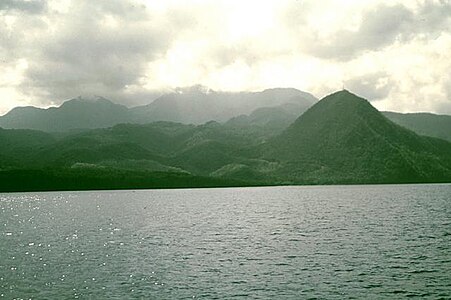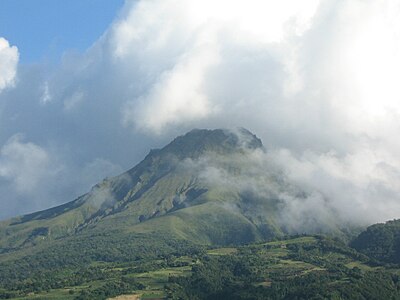List of extreme summits of the Caribbean
Appearance

This article comprises four sortable tables of major mountain summits[1] of the Caribbean that are the higher than any other point north or south of their latitude or east or west their longitude in the region.
The summit of a mountain or hill may be measured in three principal ways:
- The topographic elevation of a summit measures the height of the summit above a geodetic sea level.[2]
- The topographic prominence of a summit is a measure of how high the summit rises above its surroundings.[3][2]
- The topographic isolation (or radius of dominance) of a summit measures how far the summit lies from its nearest point of equal elevation.[4]
Northernmost high summits
[edit]| Rank | Mountain Peak | Country | Island | Elevation | Prominence | Isolation | Location |
|---|---|---|---|---|---|---|---|
| 4 | Pico San Juan[5][a] | Island of Cuba | 1140 m 3,740 ft |
500 m 1,640 ft |
408 km 253 mi |
21°59′07″N 80°07′58″W / 21.9853°N 80.1327°W | |
| 3 | Gran Piedra[6][b] | Island of Cuba | 1249 m 4,098 ft |
500 m 1,640 ft |
100.7 km 62.5 mi |
20°00′41″N 75°37′37″W / 20.0115°N 75.6270°W | |
| 2 | Pico Turquino[7][c][d] | Island of Cuba | 1974 m 6,476 ft |
1974 m 6,476 ft |
217 km 134.7 mi |
19°59′23″N 76°50′10″W / 19.9898°N 76.8360°W | |
| 1 | Pico Duarte[8][e] | Island of Hispaniola | 3098 m 10,164 ft |
3098 m 10,164 ft |
941 km 584 mi |
19°01′23″N 70°59′52″W / 19.0231°N 70.9977°W |
Southernmost high summits
[edit]Easternmost high summits
[edit]Westernmost high summits
[edit]| Rank | Mountain Peak | Country | Island | Elevation | Prominence | Isolation | Location |
|---|---|---|---|---|---|---|---|
| 6 | Pico San Juan[5][a] | Island of Cuba | 1140 m 3,740 ft |
500 m 1,640 ft |
408 km 253 mi |
21°59′07″N 80°07′58″W / 21.9853°N 80.1327°W | |
| 5 | Pico Turquino[7][c][d] | Island of Cuba | 1974 m 6,476 ft |
1974 m 6,476 ft |
217 km 134.7 mi |
19°59′23″N 76°50′10″W / 19.9898°N 76.8360°W | |
| 4 | Blue Mountain Peak[14][p][q] | Island of Jamaica | 2256 m 7,402 ft |
2256 m 7,402 ft |
273 km 169.5 mi |
18°02′47″N 76°34′44″W / 18.0465°N 76.5788°W | |
| 3 | Pic Macaya[19][y] | Island of Hispaniola | 2347 m 7,700 ft |
2087 m 6,847 ft |
216 km 134.5 mi |
18°22′56″N 74°01′27″W / 18.3822°N 74.0243°W | |
| 2 | Pic la Selle[15][r][s] | Island of Hispaniola | 2674 m 8,773 ft |
2644 m 8,675 ft |
126.6 km 78.7 mi |
18°21′37″N 71°58′36″W / 18.3602°N 71.9767°W | |
| 1 | Pico Duarte[8][e] | Island of Hispaniola | 3098 m 10,164 ft |
3098 m 10,164 ft |
941 km 584 mi |
19°01′23″N 70°59′52″W / 19.0231°N 70.9977°W |
Gallery
[edit]-
Pico Duarte is the highest summit of the Dominican Republic, the Island of Hispaniola, and the entire Caribbean.
-
The active volcano Morne Diablotins is the highest point of the island and Commonwealth of Dominica.
See also
[edit]- List of mountain peaks of North America
- List of mountain peaks of Greenland
- List of mountain peaks of Canada
- List of mountain peaks of the Rocky Mountains
- List of mountain peaks of the United States
- List of mountain peaks of México
- List of mountain peaks of Central America
- List of mountain peaks of the Caribbean
- List of the ultra-prominent summits of the Caribbean
- List of extreme summits of the Caribbean
- Caribbean
- Physical geography
Notes
[edit]- ^ a b Pico San Juan is the northernmost and westernmost 1000-meter (3281-foot) summit of the Caribbean.
- ^ Gran Piedra is the northernmost summit of its elevation in the Caribbean.
- ^ a b The summit of Pico Turquino is the highest point of the island and Republic of Cuba.
- ^ a b Pico Turquino is the northernmost and westernmost ultra-prominent summit of the Caribbean.
- ^ a b c d The summit of Pico Duarte is the highest point of the Dominican Republic, the Island of Hispaniola, and all islands of the Caribbean Sea.
- ^ The summit of Aripo Peak is the highest point of the island of Trinidad and the Republic of Trinidad and Tobago.
- ^ Aripo Peak is the southernmost 500-meter (1640-foot) summit of the Caribbean.
- ^ The summit of La Soufrière is the highest point of the island of Saint Vincent and the nation of Saint Vincent and the Grenadines.
- ^ La Soufrière is the southernmost 1000-meter (3281-foot) summit of the Caribbean.
- ^ a b The summit of Montagne Pelée is the highest point of the island and French insular region of Martinique.
- ^ a b Montagne Pelée is the southernmost and easternmost summit of its elevation in the Caribbean.
- ^ a b The summit of Morne Diablotins is the highest point of the island and Commonwealth of Dominica.
- ^ a b Morne Diablotins is the southernmost summit of its elevation in the Caribbean.
- ^ a b The summit of La Grande Soufrière is the highest point of île de Basse-Terre and the French Région Guadeloupe.
- ^ a b La Grande Soufrière is the southernmost and easternmost summit of its elevation in the Caribbean.
- ^ a b The summit of Blue Mountain Peak is the highest point of the island and the nation of Jamaica.
- ^ a b Blue Mountain Peak is the southernmost and westernmost 2000-meter (6562-foot) summit and ultra-prominent summit of the Caribbean.
- ^ a b The summit of Pic la Selle is the highest point of the Republic of Haiti.
- ^ a b Pic la Selle is the southernmost and westernmost summit of its elevation in the Caribbean.
- ^ a b Loma Alto de la Bandera is the southernmost and easternmost summit of its elevation in the Caribbean.
- ^ The summit of Main Ridge is the highest point of Island of Tobago.
- ^ Main Ridge is the easternmost 500-meter (1640-foot) summit of the Caribbean.
- ^ The summit of Mount Gimie is the highest point of the island and nation of Saint Lucia.
- ^ Mount Gimie is the easternmost summit of its elevation in the Caribbean.
- ^ Pic Macaya is the westernmost summit of its elevation in the Caribbean.
References
[edit]- ^ This article defines a significant summit as a summit with at least 100 meters (328.1 feet) of topographic prominence, and a major summit as a summit with at least 500 meters (1640 feet) of topographic prominence. All summits in this article have at least 500 meters of topographic prominence. An ultra-prominent summit is a summit with at least 1500 meters (4921 feet) of topographic prominence.
- ^ a b If the elevation or prominence of a summit is calculated as a range of values, the arithmetic mean is shown.
- ^ The topographic prominence of a summit is the topographic elevation difference between the summit and its highest or key col to a higher summit. The summit may be near its key col or quite far away. The key col for Denali in Alaska is the Isthmus of Rivas in Nicaragua, 7642 kilometers (4749 miles) away.
- ^ The topographic isolation of a summit is the great-circle distance to its nearest point of equal elevation.
- ^ a b "Pico San Juan". Peakbagger.com. Retrieved 10 May 2016.
- ^ "Gran Piedra". Peakbagger.com. Retrieved 10 May 2016.
- ^ a b "Pico Turquino". Peakbagger.com. Retrieved 10 May 2016.
- ^ a b c d "Pico Duarte". Peakbagger.com. Retrieved 10 May 2016.
- ^ "Aripo Peak". Peakbagger.com. Retrieved 10 May 2016.
- ^ "La Soufrière". Peakbagger.com. Retrieved 10 May 2016.
- ^ a b "Montagne Pelée". Peakbagger.com. Retrieved 10 May 2016.
- ^ a b "Morne Diablotins". Peakbagger.com. Retrieved 10 May 2016.
- ^ a b "La Grande Soufrière". Peakbagger.com. Retrieved 10 May 2016.
- ^ a b "Blue Mountain Peak". Peakbagger.com. Retrieved 10 May 2016.
- ^ a b "Pic la Selle". Peakbagger.com. Retrieved 10 May 2016.
- ^ a b "Loma Alto de la Bandera". Peakbagger.com. Retrieved 10 May 2016.
- ^ "Main Ridge". Peakbagger.com. Retrieved 10 May 2016.
- ^ "Mount Gimie". Peakbagger.com. Retrieved 10 May 2016.
- ^ "Pic Macaya". Peakbagger.com. Retrieved 10 May 2016.





